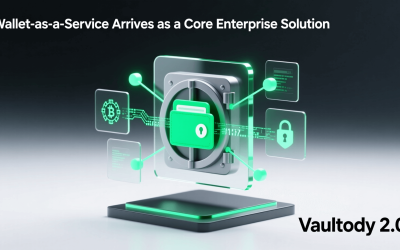What Is Custody as a Service (CaaS)?
Custody as a Service (CaaS) refers to a service model where a third-party provider delivers custody infrastructure for digital assets on behalf of businesses - fintechs, exchanges, asset managers, neobanks, and others dealing with cryptocurrencies or tokenized assets. Instead of building and maintaining internal custody systems, organizations rely on a specialized provider to securely store, safeguard, manage, and enable transactional control of assets.
Key features of CaaS include:
- Secure key management (via multi-party computation, hardware security modules, or other advanced cryptography)
- Regulatory compliance (AML/KYC integration, audit-ready logs, transaction monitoring)
- Segregation between hot, warm, and cold storage depending on liquidity and risk needs
- Governance controls: role-based access, transaction policies, approvals, multi-signature, and thresholds
For fintech and crypto organizations, CaaS allows focusing on core business development without diverting engineering resources to custody, which carries high risk and regulatory complexity.
Different Types of Custody Solutions
| Custody Type | Description | Pros | Cons | Best Fit For |
| Self-custody (in-house) | Organization builds its own custody infrastructure. | Maximum control; tailored to business needs. | High cost, complex compliance, higher operational risk. | Large institutions with strong security and blockchain expertise. |
| Multi-signature (multisig) | Key ownership split among multiple parties; multiple approvals required. | Distributed trust; transparent; widely adopted. | Slower workflows; key management overhead. | Exchanges and platforms needing governance controls. |
| Hardware Security Module (HSM) | Private keys secured in specialized hardware. | Strong isolation; institutional trust. | Costly; slower; potential single point of failure. | Cold storage and compliance-focused entities. |
| Multi-Party Computation (MPC) | Keys never exist in one place; signing occurs via distributed computation. | No single point of compromise; scalable; flexible. | Complex setup; vendor dependency. | Enterprises needing both agility and security. |
| Hybrid custody | Mix of hot, warm, and cold storage. | Balances security and accessibility. | More layers and policies to manage. | Platforms requiring both liquidity and long-term storage. |
Before choosing a CaaS, organizations should understand the major types of custody solutions available and their strengths.
Why Fintech & Crypto Businesses Need CaaS
For fintech and digital asset organizations, adopting Custody as a Service offers clear strategic benefits:
- Regulatory readiness
With global regulations tightening, CaaS providers offer built-in compliance features like KYC, AML, KYT, and detailed audit trails.
- Risk mitigation
Custody providers specialize in preventing key compromise, insider threats, and hacks by using layered security protocols.
- Operational efficiency
Building custody internally requires significant engineering resources. CaaS lets businesses allocate resources toward growth, user experience, and innovation.
- Scalability
As user bases and asset volumes grow, CaaS providers deliver infrastructure that scales across multiple assets and chains.
- Custom governance
Role-based access, approval policies, and automated transaction controls are easier to implement through dedicated custody infrastructure.
Custody as a Service (CaaS): Key Evaluation Criteria
When assessing CaaS providers, fintech and crypto organizations should evaluate:
- Security architecture: MPC, HSMs, or hybrid solutions
- Governance controls: role-based access, approval workflows, transaction whitelists
- Compliance features: audit trails, KYC/AML tools, regulatory certifications
- Resilience: redundancy, uptime guarantees, geographic distribution
- Integration: APIs and SDKs for seamless adoption
- Recovery protocols: disaster recovery, backup procedures, safe recovery mechanisms
- Cost model: transparent fee structures aligned with business scale
- Support and SLA: clear commitments for response and resolution times
Vaultody Custodial Solutions Empowered by MPC
Vaultody leverages Multi-Party Computation (MPC) technology to provide custodial solutions that combine the highest levels of security with exceptional flexibility. Its infrastructure ensures that digital assets are securely managed, compliant with regulations, and easily adaptable to the unique needs of fintech and crypto organizations.
Vaultody’s Wallet as a Service (WaaS)
Vaultody offers Wallet as a Service (WaaS), a secure and scalable wallet infrastructure designed for enterprises handling digital assets. Key features include:
- Enterprise-grade security using advanced cryptographic methods such as MPC for key protection
- Scalability to support high transaction volumes and multiple digital assets
- Compliance support with audit trails and monitoring tools
- Recovery mechanisms that allow organizations to safely restore wallet access in emergencies
- API and SDK integration for fast adoption and simplified development
These capabilities highlight the same qualities organizations should demand from CaaS solutions: security, compliance, reliability, and scalability.
When to Adopt Custody as a Service
Organizations should consider CaaS when:
- Regulatory requirements increase
- Assets under management or transaction volumes grow significantly
- Expansion into new jurisdictions introduces compliance challenges
- In-house custody becomes costly or risky
- Faster time-to-market for wallet-based services is required
Best Practices for Implementing CaaS
- Perform due diligence: verify audits, certifications, and provider track record
- Define governance policies: set clear internal approval and transaction rules
- Test security and recovery: simulate breaches and ensure recovery procedures are robust
- Integrate monitoring: use real-time alerts and reporting dashboards
- Plan for growth: choose a provider capable of scaling with your assets, users, and supported blockchains
Conclusion
Custody as a Service (CaaS) is becoming indispensable for fintech and crypto organizations managing digital assets. It offers a secure, compliant, and scalable alternative to building custody in-house, while enabling businesses to focus on product innovation and market expansion.
Paired with Wallet as a Service (WaaS), CaaS creates a complete infrastructure stack: custody ensures security and compliance, while WaaS enables operational flexibility and user engagement. For organizations in the digital asset economy, adopting CaaS is not just a technical decision - it is a strategic one.









 Copy link
Copy link